Freightliner Group
Freightliner Group is a rail freight and logistics company, formed in the United Kingdom in 1995, and now having expanded into Australia, The Netherlands and Poland. Freightliner Limited is the largest intermodal freight transport operator in the United Kingdom[3] and the second largest freight operating company in the country by revenue, behind DB Cargo UK.[4] It is a subsidiary of Genesee & Wyoming.
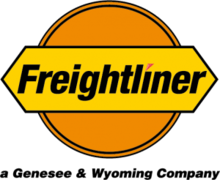 | |
| Private | |
| Industry | Rail freight transport |
| Predecessor | British Rail |
| Founded | 1995 |
| Headquarters | Fitzrovia, , United Kingdom |
Area served | Europe Australia Middle East |
Key people | Gary Long (CEO) |
| Services | Bulk freight, Intermodal freight transport and logistics |
| Revenue | US$785 million[1] |
Number of employees | 2,500+[2] |
| Parent | Genesee & Wyoming (95%) Management (5%) |
| Divisions | Intermodal, Heavy Haul, Maintenance |
| Subsidiaries | European Rail Shuttle |
| Website | www |
History
British Rail
The idea of shipping freight in set-sized containers went back to the 1930s in the UK with the adoption of the Conflat system. But it was Dr Richard Beeching who in his report Reshaping Britain's Railways who advanced the concept of containerised freight in the UK.[5]
Beeching proposed 55 depots placed strategically across the UK, serviced by fixed-consist permanently-coupled air-braked trains, with an average journey between depots of 150miles and a shortest distance of 50miles. British Railways progressed with the concept, envisaging 40 ft length wagons - later increased to 60 ft - carrying 8 ft by 8 ft standard sized international shipping containers in lengths to 10 ft to 27 ft, later adapted to 20 ft to 40 ft (NB: These BR UK adopted standards were formed on the basis of analysis of then current international intermodal practise, and latter adopted as the base of the internationally agreed ISO 668). Containers would be loaded at the dedicated inland terminals, using gantry cranes for transshipment between road and rail.[6]
The prototype flat wagon was produced by Shildon railway works in January 1964, with 100 production wagons turned out later that year from Ashford railway works.[5] The first revenue-earning train ran between York Way/Maiden Lane in North London and Gushetfaulds in Glasgow on 15 November 1965.[5] Soon adopting the Freightliner name, the first single-shipper train was operated on 20 August 1968, hauling specially-designed 30-foot containers carrying parts for Ford Escort cars that were destined for assembly in plants on the European mainland.[7]
Freightliner Ltd (1968)
Beeching's original concept envisioned Freightliner servicing a domestic freight market, which by 1968 had resulted in British Railways developing 17 purpose-built depots. However, Freightliner's most profitable routes were those servicing Britain's major ports, specifically traffic to/from Europe and Ireland, as well as import/export traffic to the rest of the world. This pattern of profitability was recognised in the 1968 Transport Act, where by Freightliner became a separate listed commercial company wholly owned by the UK Government, but which leased its UK domestic rail transport from British Railways.[5]
Although by the late 1960s Freightliner had 28 terminals and 56 routes, the company's shift in focus from the original domestic freight market to the international market serviced via ports continued for the next 30 years, with many of the original domestic depots which did not service port traffic either never opening or eventually closing (ie: Kings Cross, Sheffield, Swansea, Swindon), whilst investment in seaport depots - specifically Southampton, Harwich, and the Port of Felixstowe where Beeching's plan had never envisaged a depot - continued at an increasing pace.[5] Part of the consolidation of rail depots was enabled by a greater focus on Freighliner's own HGV network of dedicated lorries, which expanded the servicing footprint of each rail depot, and hence allowed increased efficiency through creating longer and better utilised train routes.[5]
Dudley Freightliner Terminal, 10 miles (16 km) from Birmingham, on the site of the old railway station was opened in October 1967. This initially proved to be one of the most profitable such terminals in the country, while the Birmingham terminal was ultimately one of the least financially viable. In 1981, due to a lack of international traffic, Freightliner was planning to close Dudley and transfer its function to Birmingham. Given a reprieve in 1983, it finally closed in 1986.[8]
Increasing Irish traffic resulted in a depot being opened at the Port of Holyhead, as well as Freightliner having dedicated operations in both Belfast and Dublin.[5] This also resulted in UK Government granting Freightliner funds to create a dedicated multimodal terminal at the Port of Liverpool to replace its previously lost rail freight traffic, and then further investment in second multimodal terminals at both Felixstowe and the Port of Tilbury.[5]
Return to British Railways
.jpg)
The 1978 Transport Act brought Freightliner back inside the control of British Railways, mostly driven by the investment required to enable shipping of both 8 ft 6inch and 9 ft height containers across the loading gauge restricted UK rail network.[5]
Freightliner immediately made a major pitch to the BR Board to allow 8 ft 6in boxes to be carried on the East Coast Main Line (ECML), which involved lowering the track in Stoke area, as well as the tunnels at Peascliffe and Penmanshiel. The work was successfully completed at Stoke and Peascliffe, but Penmanshiel Tunnel collapsed during the project.[9] The extent of the collapse meant that reconstruction was too expensive, resulting in the abandonment of around one kilometre (1,100 yards) of the existing ECML (including the tunnel itself), being replaced by a new section of line constructed in open cut to the west of the original course.[10] The operation to reopen the railway took five months of round-the-clock working.[10] Contractor Sir Robert McAlpine & Sons Ltd started work on the new alignment on 7 May 1979, and it was completed on 20 August.[9][11] As a result of the work to re-align the railway line, it was also necessary to alter the course of the A1 trunk road.[12] Ironically Freightliner would later withdraw its services on that stretch of the ECML.[5]
In the 1980s, Freighliner became part of BR's 1980s non-bulk Railfreight Distribution (RfD) division, which brought about its first ever allocation of locomotives. After experimenting with other rail operators solutions to coping with the new larger containers, in 1990 BR agreed the order of 700 flat-wagons from SNCF supplier Arbel Fauvet Rail, which could immediately accommodate 8 ft 6inch height containers at 75 mph speeds.[5] This was further supplemented in 1991 with leased flat-wagons from Tiphook.[5] Further experimentation with SNCF-leased Multifret flat-wagons - which could accommodate 9 ft containers at speeds of up to 90 mph - led to the initial ordering of 45 BR specified Lowliner wagons, which with a deck height of just 720mm could accommodate 9 ft high containers, on routes approved for 8 ft 6inch containers using the existing wagon fleet.[5]
Although designed to accommodate 9 ft containers over the entire BR network, the slow output of Lowliners meant that the entire allocation were utilised to service London Thamesport, enabling the transport of 8 ft 6inch containers on the restricted loading gauge of the former South Eastern and Chatham Railway.[5] The withdrawal of Sealinks dedicated freight service from Holyhead also brought about the end of Freightliner's dedicated service to Northern Ireland via North Wales.[5]
Privatisation - Freightliner (1995) Ltd
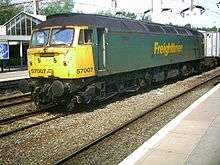
As part of the Privatisation of British Rail, the loss-making RfD division came under increasing pressure, leading to the immediate closure of the Speedlink division. Freightliner closed the residual domestic-serving depots, including London's Willesden and Stratford, Bristol (closed in 1992, later reopened in 2014) Glasgow Gushetfaulds, and consolidation of Manchester's traffic on the newly opened Euroterminal (later switched back to the previously closed Trafford Park).[5]
The Freightliner business unit had its assets transferred into a new company, Freightliner (1995) Limited, in preparation for sale.[13] Rejected as not sufficiently profitable by the Wisconsin Central-owned English Welsh & Scottish Railway,[5] on 25 May 1996 Freightliner was purchased by a management buyout backed by 3i and Electra Private Equity for a sum of £5.39M.[14] As part of the sale agreement, the UK Government awarded the company a track-access grant of £75M up until the year 2000.[5]
Freightliner's immediate need for was for improved reliability from its locomotive fleet. In 1997 the company commissioned Brush Traction to rebuild of six of its Class 47's to create the Class 57 design, with reconditioned General Motors power units and reworked ex-Class 56 alternator groups. The first of these was released in July 1998, and coincided with the unveiling of the new British Racing Green Freightliner livery. After an evaluation period Freightliner was sufficiently impressed to order a further six in June 1999, with plans for an eventual fleet of twenty-five.[15] However, in the event no more were rebuilt, with Freightliner switching to new-built Class 66s, with all leased from Porterbrook.
In 1999, Freightliner set up its Heavy Haul business. In March 2004 Freightliner launched Logico, providing short-term or one-off spaces on intermodal trains. In 2007 Freightliner commenced operations in Poland.[5]
Post-privatisation
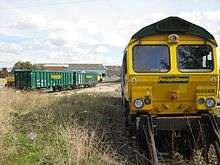
On 13 June 2008, Freightliner Group was purchased by Railinvest Holding Company Limited,[16] a subsidiary of Arcapita Bank of Bahrain.[17][18]
In June 2009, Freightliner commenced operations in Australia.
In February 2015, Freightliner was sold by Arcapita Bank to American company Genesee & Wyoming. Under the deal, Genesee & Wyoming purchased a 95% shareholding which will increase to 100% by 2020.[19]
On 12 November 2015, British Rail Class 47 No. 47830 (D1645), which is operated by Freightliner, was named Beeching's Legacy to mark 50 years since the first container train ran under British Rail.[20]
In April 2018, Freightliner unveiled its new brand identity during an event at the NEC Birmingham, bringing the brand inline with parent company Genesee & Wyoming.[21]
On 1 July 2019, it was announced that Genesee & Wyoming is to be bought for US$8.4bn by a consortium including Brookfield Infrastructure, GIC and Brookfield's institutional partners.[22]
Subsidiaries
Freightliner Group has the following subsidiaries:[23]
- Freightliner Ltd
- Freightliner Heavy Haul
- Freightliner Maintenance (has maintenance facilities in the United Kingdom at Crewe Basford Hall and Leeds Midland Road)[24]
- Freightliner Poland and Germany
- European Rail Shuttle B.V.
- Freightliner Australia
- Freightliner Middle East
Operations
United Kingdom
When Freightliner was privatised in 1996, it only operated Intermodal container services. These ran from ports including Felixstowe, Southampton and Tilbury to terminals such as Birmingham, Trafford Park in Manchester, Stourton (Leeds), Coatbridge (Central Scotland), Ashton Gate (Bristol), and Wentlooge (Newport, South Wales). The network has been expanded with additional destinations added.[25] Freightliner also operate an extensive road distribution network with 300 road vehicles. Freightliner also provides drivers for Scottish TransPennine Express services.
In 1999, Freightliner set up Heavy Haul initially operating railway infrastructure trains for Network Rail moving ballast, rails etc. before moving into other bulk loads including aggregates, cement, coal, petroleum, scrap metal and waste. Initially run as a division of Freightliner Limited, in 2001 operations were transferred to a new subsidiary, Freightliner Heavy Haul Limited.[26]
In April 2006, Freightliner Maintenance Limited was established as a separate entity dedicated to the repair and maintenance of traction and rolling stock.[27]
Poland
In 2006, Freightliner expanded its operations into Poland. A subsidiary company, Freightliner PL Sp. z o.o., was established to bid for contracts hauling coal traffic.[28] The first contract was for coal transport from Lubelski Węgiel Bogdanka SA near Bogdanka (Bogdanka-Lublin coal mine) to Kozienice Power Station. The service began in September 2007.[29][30] Most of Freightliner PL's services operate on the Gdańsk to Warsaw corridor and in southern Poland. In February 2015, Freightliner PL signed a €17·5m contract to lease five Newag Gliwice 5 MW electric six-axle E6DCF Dragon locomotives from ING Lease. With each equipped with a 520 kW diesel engine for last-mile operation, they are scheduled to be delivered from May to July 2016.[31]
Australia
Freightliner began exploring opportunities in the Australian rail market with Freightliner Australia Pty Ltd established by April 2007. By June 2008 Freightliner Australia had been accredited as a rail operator in the state of New South Wales[32] and by September 2009 also had accreditation in Queensland and Western Australia. In June 2009 Freightliner Australia commenced operating containerised cotton services from Wee Waa to Port Botany.[33][34] In September 2009 Freightliner Australia signed a 10-year deal with Xstrata to haul export coal from the Hunter Valley to Newcastle, commencing in late 2010.[35] Under the deal Xstrata own the rolling stock with Freightliner Australia providing the engineering, logistics, maintenance and operational support.[36] In May 2012 Freightliner Australia commenced operating a Warren to Port Botany service.
In October 2016, Glencore, who had purchased Xsrata, sold its Hunter Valley coal haulage business to Genesee & Wyoming Australia that is also owned by Freightliner's parent company Genesee & Wyoming. The deal which is subject to regulatory approval, is expected to close on 1 December 2016.[37]
Netherlands
In 2013, Freightliner bought Netherlands-based intermodal container operator European Rail Shuttle B.V. from Maersk Line.[38]
Fleet
United Kingdom
Freightliner inherited a fleet of ageing Class 47 diesel locomotives and Class 86 and Class 90 electric locomotives from British Rail.
In 1997, Freightliner placed an order for six Class 57 locomotives. These were rebuilt by Brush Traction at Loughborough from Class 47s and fitted with a refurbished EMD engine and a reconditioned alternator, improving reliability and performance. The first was delivered in July 1998. After an evaluation period Freightliner was sufficiently impressed to order a further six in June 1999.[39]
Various orders were placed for Class 66s with 111 eventually delivered. These replaced all of the Class 47s by 2004 and the Class 57s by 2008. Freightliner also leased some Class 66s formerly operated by Direct Rail Services.
In November 2007, Freightliner announced an order for 30 Class 70s under a project called Project Genesis.[40] The first two were delivered in November 2009. These have released a number of Class 66s with five going to Colas Rail, 13 to Freightliner Poland and four to GB Railfreight.[41]
Freightliner also use their single class 47 (47830) on driver route learning.
Poland
Freightliner PL ordered seven EMD Class 66s as well as 432 Greenbrier Eamnoss type coal hopper wagons. These have been supplemented by an EMD Class 66 formerly used by Häfen und Güterverkehr Köln and 12 Class 66s transferred from Freightliner's UK operations. A 13th was sent from the UK in October 2012. These units underwent various modifications to allow them to operate on the Polish network.[42]
Australia
Freightliner Australia commenced operations using hired in GL class locomotives from Chicago Freight Car Leasing Australia. After a longer term lease was agreed, two were repainted into Freightliner livery in September 2010.[43] The Warren service that commenced in May 2012 also uses locomotives hired from CFCLA. The Xstrata coal contract is operated by XRN class locomotives that are owned by the customer.[44][45] Wagon types are PHEH and PHYH for the coal traffic and CQBY, CQFY and CQYY on the grain traffic.[46]
In January 2015, two G class locomotives were purchased.[47]
Fleet detail
United Kingdom
| Class | Image | Type | Built | Wheel arr. | In traffic | Numbers |
|---|---|---|---|---|---|---|
| 08 |  |
Diesel Shunter | 1953 | 0-6-0 | 10 | 08077/530-1/575/585/624/691/764/785/891 |
| 59 | 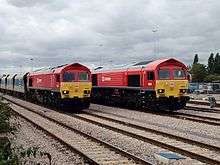 |
Diesel locomotive | 1994–1995 | Co-Co | 6 | 59201 - 206 Acquired from DB Cargo in 2019[48] |
| 66 | 1999 | 127 | 7 66/4: 413-6/418-420
94 66/5: 501-20/522-81/585/587-99 19 66/6: 601-7/610/613-23 7 66/9: 951-7 | |||
| 70 | 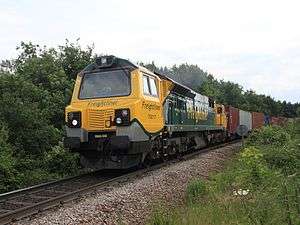 |
2009 | 19 | 70001-11/013-020 | ||
| 86 | Electric locomotive | 1965 | Bo-Bo | 16 | 16 86/6: 604-5/607-10/612-4/622/627-8/632/637-9
Will eventually be phased out by 13 Class 90s from Greater Anglia.These will then be overhauled and re-introduced to expand electric freight services.[49] | |
| 90 | .jpg) |
1987 | 23 | 90003-16/90041-9 | ||
| Total | 188 |
Poland
| Class | Image | Type | Introduced | Wheel arr. | In traffic | Numbers |
|---|---|---|---|---|---|---|
| EMD Series 66 | Diesel | 2006-07 | Co-Co | 13 | 66008-011, 013-015 & 66601-606[50] | |
| Newag Dragon E6ACTd | Electric (Diesel last-mile slave) |
2016 | 5 | E6ACTd-101 - E6ACTd-105 | ||
Australia
| Class | Type | Introduced | Wheel arr | In traffic | Numbers |
|---|---|---|---|---|---|
| GL Class | Diesel | 1971-72 remanufactured 2004 | Co-Co | 2 | GL111-112 |
| XRN Class | 2010-12 | 30 | XRN001-030 | ||
| G Class | 1988 | 2 | G533, G535 | ||
Netherlands
| Class | Type | Introduced | Wheel arr. | In traffic | Numbers | Notes |
|---|---|---|---|---|---|---|
| Vossloh G1206 | Diesel | Bo-Bo | Shunting and local operations | |||
| Vossloh G 2000 | ||||||
| EMD Class 66 | Co-Co | Withdrawn, lease ended | ||||
| BR182 (Siemens ES 64 U2) | Electric | Bo-Bo | ||||
| BR185 (Bombardier TRAXX) | ||||||
| BR189 (Siemens ES 64 F4) | ||||||
Gallery

- 57012 Freightliner Envoy at Ipswich on 31 January 2004
 66534 OOCL Express in the Freightliner livery introduced in 1998 at Virginia Water in April 2004
66534 OOCL Express in the Freightliner livery introduced in 1998 at Virginia Water in April 2004- 66605, with Freightliner 40 1965-2005 at Dundee on 6 June 2007
- 66 610 on the East Coast Main Line near York on 8 March 2008
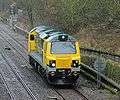 70001 leaves Clay Cross Tunnel working 0Z70 Lawley Street - Leeds Midland Road
70001 leaves Clay Cross Tunnel working 0Z70 Lawley Street - Leeds Midland Road- 86613 and 86610 at Ipswich on 14 February 2004
 The Freightliner maintenance depot at Leeds Midland Road.
The Freightliner maintenance depot at Leeds Midland Road.
References
- G&W agrees to buy Freightliner Group Accessed 25 February 2015
- Careers Accessed 1 Sep 2015
- Freight on Rail Members Accessed 30 April 2014
- Britain's Railways Today - Freight
- "Freightliner's 50 years". Railways Archive. 23 December 2015. Retrieved 16 April 2019.
- "British Railways Board Freightliner Brochure 1965" (PDF).
- "Fords run first company Freightliner". Modern Railways. Shepperton, Middlesex: Ian Allan Ltd. XXIV (241): 551. October 1968.
- Doherty, Andrew. "Dudley Station". Rail Around Birmingham.
- Report on the Collapse of Penmanshiel Tunnel that occurred on 17th March 1979 by Lt. Col. I.K.A. McNaughton, 2 August 1983, Her Majesty's Stationery Office, London, England.
- Biddle, Gordon (1990). The Railway Surveyors. London: Ian Allan Ltd. and British Rail Property Board. ISBN 0-7110-1954-1.
- Nock and Cross (1982) pp 192–193.
- http://maps.google.co.uk/maps?ie=UTF8&oe=UTF-8&hl=en&q=&ll=55.88417,-2.305584&spn=0.044481,0.159645&z=13&iwloc=addr&om=1%5B%5D%5B%5D
- Companies House extract company no 3118392 Freightliner (1995) Limited
- "Secretary of State for Transport publication 27 November 1996".
- "Freightliner signs deals for five 66s and six 57s" Rail issue 358 2 June 1999 page 4
- Companies House extract company no 6522978 Railinvest Holding Company Limited
- "Freightliner acquired by Arcapita". 13 June 2008.
- "Electra Priv Equity ELTA Final Results". Bloomberg. 13 June 2008.
- Genesee & Wyoming Inc Enters into Agreement to Acquire Freightliner Group Limited Genesee & Wyoming 24 February 2015
- "Freightliner marks 50 years with a naming". The Railway Magazine. Vol. 161 no. 1, 377. Horncastle, Lincs: Mortons Media Group. 2 December 2015. p. 7. ISSN 0033-8923.
- Freightliner unveils new brand identity at Multimodal Freightliner 2 May 2018
- "Genesee & Wyoming to be acquired in US$8·4bn deal". Railway Gazette. 1 July 2019. Retrieved 7 July 2019.
- Today's Railways Europe, Issue 232, April 2015, page 10, ISSN 1354-2753
- Bendall, Simon (January 2017). "New Basford Hall TMD unveiling with remembrance naming". Rail Express. No. 248. Horncastle: Mortons Media. p. 15. ISSN 1362-234X.
- "Freightliner Intermodal Terminal & Ports Network".
- Companies House extract company no 3831229 Freighliner Heavy Haul Limited
- Companies House extract company no 5713164 Freightliner Maintenance Limited Limited
- Freightliner prepares to compete in Poland, 1 March 2007
- "Freightliner PL wykona zlecenie dla LW Bogdanka", rynekinfrastruktury.pl (in Polish), 26 September 2011
- "Polish freight progress", railwaygazette.com, 19 October 2007
- "Freightliner PL orders Dragon locomotives". Railway Gazette. 2 February 2015.
- "NSW Accredited Operators". Independent Transport Safety and Reliability Regulator. transportregulator.nsw.gov.au. Archived from the original on 19 June 2008. Retrieved 30 June 2008.
- "Freightliner Australia begins with cotton contract". Railway Gazette. 2 July 2009. Retrieved 23 April 2014.
- Sam Collyer (2 July 2009). "UK's Freightliner enters Australian rail market". Lloyd's List DCN. lloydslistdcn.com.au. Retrieved 4 July 2009.
- "Freightliner signs deal with Xstrata Coal" (PDF). Media Release. freightliner.co.uk. 25 September 2009. Retrieved 18 November 2009.
- "Xstrata launches its own rail service". Fairfax Media Publications Pty Ltd. 12 September 2010. Retrieved 23 April 2014.
- G&W and Macquarie to buy Glencore Rail coal haulage business Railway Gazette International 20 October 2016
- "Freightliner Group announces acquisition of ERS Railways", railwaygazette.com, 19 June 2013
- Rail Magazine (556): 54, 3 January 2007 Missing or empty
|title=(help) - "GE enters UK loco market". Railway Gazette International. 26 November 2007.
- AB Rail UK Loco database, archived from the original on 31 August 2012
- FPL 66s Revised Data Table 15 March 2012
- Motive Power magazine issue 76
- Xstrata Fleet List
- XRN Class
- "FLA". Freightliner.
- Change of ownership of Locomotives G533 and G535 Australian Rail Track Corporation 9 January 2015
- https://rail-record.co.uk/class-59-2-freightliner/
- Clinnick, Richard (31 July 2020). "Class 86s to be overhauled and re-introduced". Twitter.
- "Diesel Locomotives". AbRail Rail Databases.
Further reading
- Hunt, John (17–30 December 1997). "All night long...". RAIL. No. 320. EMAP Apex Publications. pp. 18–23. ISSN 0953-4563. OCLC 49953699.
- Hunt, John (25 February – 10 March 1998). "All day and all of the night". RAIL. No. 325. EMAP Apex Publications. pp. 36–41. ISSN 0953-4563. OCLC 49953699.
- Holley, Mel (21 October – 3 November 1998). "Freightliner to hit 50% growth two years earlier than anticipated". RAIL. No. 342. EMAP Apex Publications. p. 13. ISSN 0953-4563. OCLC 49953699.
External links
| Wikimedia Commons has media related to Freightliner. |